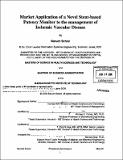| dc.contributor.advisor | Richard J. Cohen and T. Forchet Dagi. | en_US |
| dc.contributor.author | Schori, Baruch | en_US |
| dc.contributor.other | Sloan School of Management. | en_US |
| dc.date.accessioned | 2007-01-10T16:30:38Z | |
| dc.date.available | 2007-01-10T16:30:38Z | |
| dc.date.copyright | 2006 | en_US |
| dc.date.issued | 2006 | en_US |
| dc.identifier.uri | http://hdl.handle.net/1721.1/35516 | |
| dc.description | Thesis (S.M.)--Harvard-MIT Division of Health Sciences and Technology; and, (M.B.A.)--Massachusetts Institute of Technology, Sloan School of Management, 2006. | en_US |
| dc.description | Includes bibliographical references (p. 79-82). | en_US |
| dc.description.abstract | The use of stents following angioplasty in ischemic arterial beds is limited by complications and continuing vascular deterioration. A phenomenon called stent restenosis post procedure exists which puts patients at a relatively high risk for vessel stenosis and occlusion. Stent restenosis may eventually lead to clinical symptoms such as myocardial infarction, stroke or limb loss, and if overlooked might lead to death. Within five years of stenting, a significant portion of patients require additional surgical intervention. A novel stent-based, implantable, and wireless approach for real-time monitoring of vessel patency at the site of coronary stents is proposed, will provide a measure of efficacy of stenting and of the pharmacologic regiment to mitigate the risk of vessel stenosis and narrowing due to the underlying. The purpose of this thesis is to explore and test the Hypotheses that there is a market for a direct, non-invasive monitoring of vessel patency at the site of a coronary stent; and that an implantable, wireless, stent-based device to monitor blood flow rate through a coronary stent can be designed and built. | en_US |
| dc.description.abstract | (cont.) A literature survey of late clinical studies and the opinion of numerous specialist clinicians collected in interviews and preliminary questionnaire, demonstrate sufficient clinical ambiguity regarding the safety of coronary stents, including Drug-Eluting Stents (DES) portrait an underserved clinical need to justify the introduction of a direct, non-invasive modality for post-op monitoring of vessel patency at the site of a coronary stent. | en_US |
| dc.description.statementofresponsibility | by Baruch Schori. | en_US |
| dc.format.extent | 82 p. | en_US |
| dc.format.extent | 3652790 bytes | |
| dc.format.extent | 3656160 bytes | |
| dc.format.mimetype | application/pdf | |
| dc.format.mimetype | application/pdf | |
| dc.language.iso | eng | en_US |
| dc.publisher | Massachusetts Institute of Technology | en_US |
| dc.rights | M.I.T. theses are protected by copyright. They may be viewed from this source for any purpose, but reproduction or distribution in any format is prohibited without written permission. See provided URL for inquiries about permission. | en_US |
| dc.rights.uri | http://dspace.mit.edu/handle/1721.1/7582 | |
| dc.subject | Harvard University--MIT Division of Health Sciences and Technology. | en_US |
| dc.subject | Sloan School of Management. | en_US |
| dc.title | Market application of a novel stent-based patency monitor to the management of ischemic vascular disease | en_US |
| dc.type | Thesis | en_US |
| dc.description.degree | M.B.A. | en_US |
| dc.description.degree | S.M. | en_US |
| dc.contributor.department | Harvard University--MIT Division of Health Sciences and Technology | |
| dc.contributor.department | Sloan School of Management | |
| dc.identifier.oclc | 71823839 | en_US |
